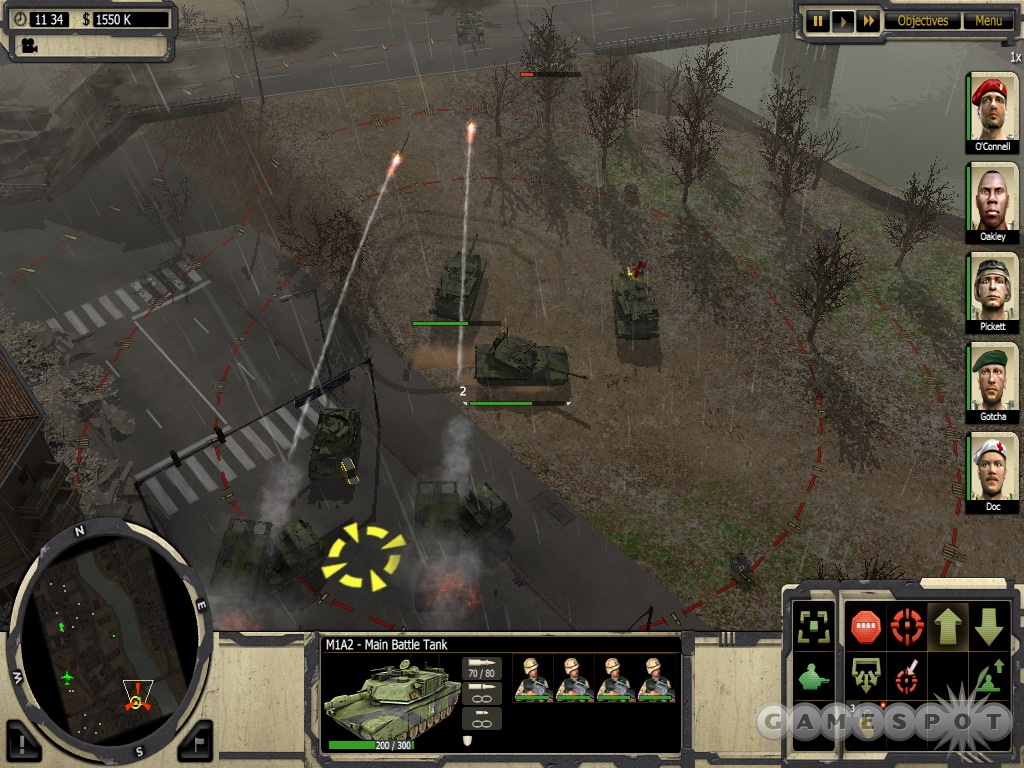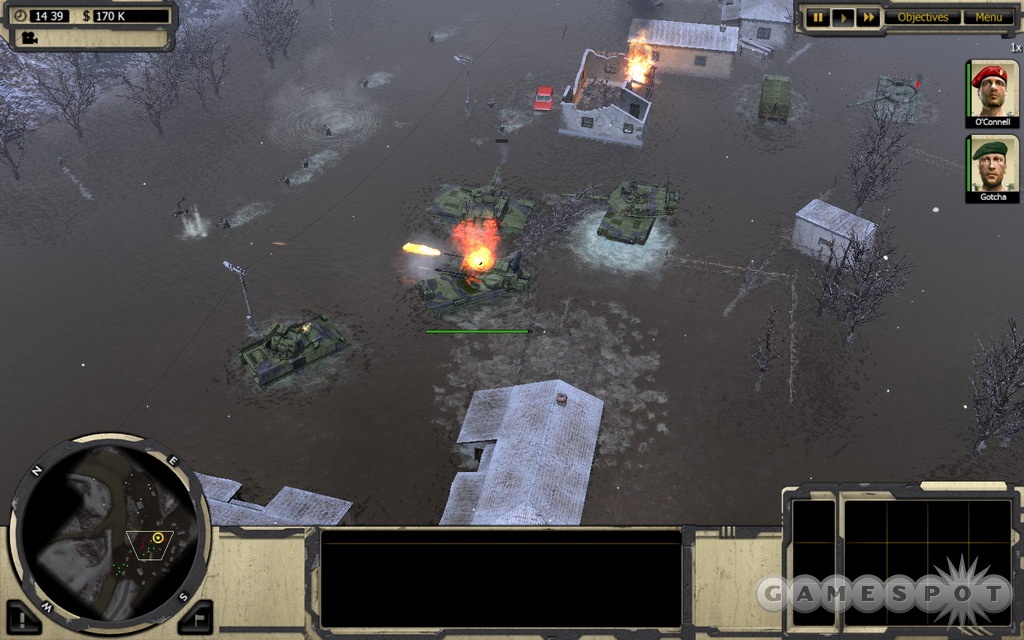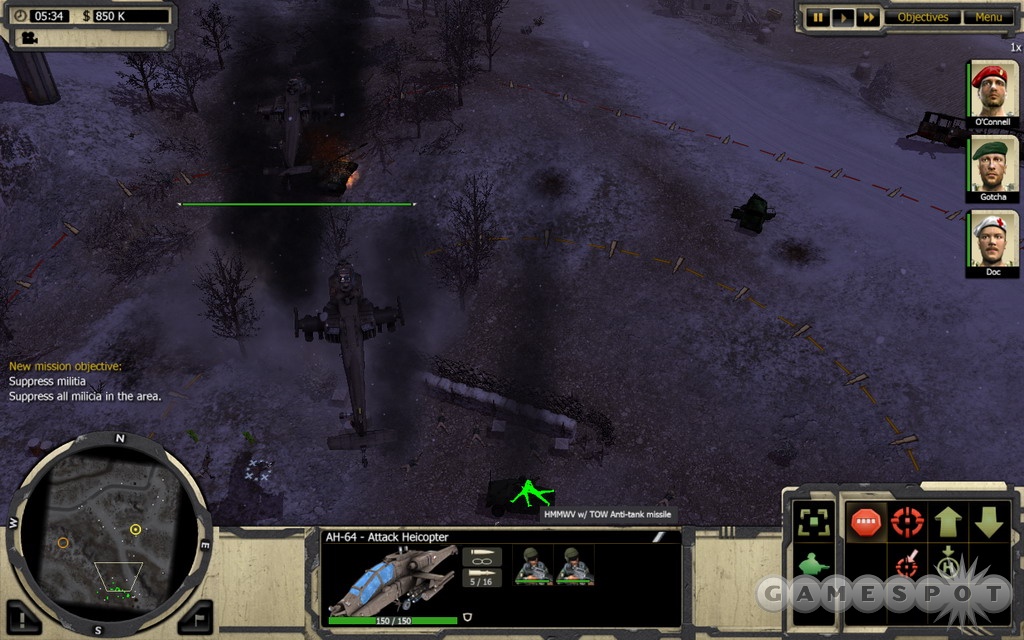Modern military combat is a popular subject, and what self-respecting strategy gamer doesn't want to play with the latest and greatest tanks and weaponry? That's the idea behind Joint Task Force, a strategy game that envisions a world where the answer to many of the world's ills are an M1 Abrams tank and a company of US Army Rangers. Unfortunately, we know that such operations can end in a quagmire in the real world, and Joint Task Force suffers from some similar issues.

The fictional Joint Task Force is a multinational peacekeeping unit formed by the Western nations to put the muscle back into peacekeeping, and the game takes the JTF around the world as it attempts to stamp out a terrorist organization with shades of Al-Qaeda. The JTF is apparently a shoestring operation, though, because it literally has to fight for its funding while on the battlefield. The game's mechanics are set up so that you start off with a limited handful of assets in most missions and then are rewarded cash for completing objectives. You can then use that cash to purchase reinforcements, from RPG-wielding Rangers to Humvees to helicopters to satellite scans of the battlefield. The missions are fairly straightforward and consist mainly of going from point A to point B to accomplish an objective (usually blasting everything in the area), only to be notified by the JTF commander to go to another point on the map and carry out the same objective. In essence, you're maneuvering around the level like a rat in a maze until you finally get to the end, at which point it's on to the next mission to repeat the process.
The big issue with the game is that combat, which should be the heart of Joint Task Force, is a lot of work and not that much fun. The action happens so fast that it's very unforgiving if you make a mistake, which is easy to do since the game requires an intense amount of micromanagement. You have to give your guys basic orders, like telling infantry to shoot at a nearby enemy that suddenly pops into view while they're crawling around the ground or telling a tank crewman to button up in his vehicle if he's getting shot at. A lot of times, troops get wiped out before you know it, and since you only have a handful of forces to rely upon, this usually means reloading to a previous save (thankfully, you can save at any point) and trying again till you get it right. Or, if one of a mission's critical characters gets killed (which happens often), you'll instantly fail and have to reload again. Sure, you can pause the game to give orders, but this brings the action to a crawl, and it's not possible in the game's multiplayer or cooperative multiplayer modes.
This translates into a game where the pace feels off. Instead of spending most of the time immersed in fighting, you'll be spending time cautiously moving forward, taking out a group of enemies, and then pulling everyone back for healing and repair. It takes a couple of minutes for the medics and repair vehicle to move up and do their work, so you spend a lot of time sitting around, waiting on repairs or doing mundane tasks. For example, crossing a river becomes a tedious affair in micromanagement, as you have to transport all your vehicles on a ferry one at a time, loading and unloading the units, and then sending the ferry back and forth across the river.

Combat is so lethal that there's no chance to explore tactics of any kind. Units have a very rock-scissors-paper balance to them, so there's little focus on maneuvers and no room for unconventional thinking. For example, if you can put a surveillance drone over an enemy area to locate surface-to-air missile launchers, why can't you then purchase the cruise missiles or the stealth-fighter missions that are in your purchase screen and take them out? Instead, the game requires you to use your ground forces and take losses, even though air strikes and cruise missiles were developed to avoid this situation altogether. These gameplay contrivances can add up. Tanks can pop smoke grenades and hide in the thick clouds, but somehow the game glosses over that Western tanks have had thermal sights that can see through smoke for decades, which is frustrating when you're in a desperate tank battle and have to wait for smoke to disappear before your tanks can fire at an enemy tank again. In the meantime, an enemy infantryman will run into view, and your tanks will forget all about the other tank and focus on the lesser target, at which point the smoke will dissipate and the enemy tank has a clear shot at your guys.
As you can tell, your guys need a lot of hand-holding, and aside from ducking, they don't seek out cover all that well. In fact, despite that you're fighting in a lot of dense, city environments, there's not that much cover in the game. Every now and then there are sandbags that your guys can sidle up against, and the tiny little green arrows on the ground indicate they can be used for cover. However, these are the only items in the game that let you do this, as you can't tell troops to duck behind the pillars of a building or behind a car in the same way. The artificial intelligence also has pathfinding issues, particularly with tanks in a tight setting, and you'll see your elite troops drive in circles as they try to follow your orders.
To be fair, Joint Task Force does try to introduce interesting concepts. For instance, the game tries to model today's media atmosphere by keeping score of collateral damage. The more civilians that are killed, the worse it is for you, because the ever-present media projects the casualties to the rest of the world. And, in a game where you've got to fight for cash to purchase reinforcements, bad PR can be a nightmare. However, as admirable an idea this is for a game, it doesn't quite come across that effectively, especially since we rarely had any issues with avoiding civilian casualties. Also, it's ironic that even if you avoid civilian casualties the media will still complain about your methods. The multiplayer is fun and fast-paced, with some innovative modes, as well. Dominion, for instance, has you capturing flags on the map, which generates funds that you can use to request reinforcements, so you'll see helicopters darting across the battlefield constantly to deliver fresh troops. There are three playable factions in multiplayer, so it's not all Joint Task Force squads going against one another, and you can see a wide array of modern military vehicles from around the world blow up.

On a machine that exceeded the recommended specs, the game ran a bit clunky, and some levels, such as an oil-rig mission, brought the frame rate to a crawl. Still, Joint Task Force is a very pretty game, and it's downright cool to see modern military machines tear apart the environment. Tanks will roll through forests and fences, explosions will gut buildings, and incredibly sleek Black Hawks will swoop over the map to deliver reinforcements and supplies. It's arguable whether modern warfare has ever looked so good in a strategy game. Unfortunately, the audio isn't up to the same standards, as the corny voice-over work will remind you of certain Saturday Night Live skits, where the comedians play with their foreign accents. The rest of the sounds are fairly run of the mill, as you'll hear the background sounds that you'd expect, such as the whoop of helicopter blades and bursts of gunfire.
Joint Task Force is a game that exhibits flashes of fun at times, like when you finally cut loose with your Apache helicopters and have them mercilessly hunt enemies down on the map. Still, it's hard to recommend this game unless you're really into strategy games that require heavy micromanagement.



